Site and Machine ID (MID) code value pairs are generated by protected applications on remote computers.
Site code
Site code is a 32bit hexadecimal number which represents unique computer signature. It is calculated accordingly to locking parameters and Application signature settings.
Site code is always formatted as zero padded, eight characters long (XXXXXXXX), hexadecimal (valid characters: 0-9, A-F) value.
Machine ID (MID) code
MID code is an encrypted digital representation of locking parameters from remote computer.
It has the following structure: XXXX-XXXX-XXXX-XXXX where each XXXX represents zero padded, four characters long, 16bit hex value (for example: A19F-8A20-019D-19A8).
MID code goes in pair with Site code. Different Site code will result in different MID for same computer. For example, when license is removed, protected application will generate different set of Site/MID codes on next run.
MID code also depends on project settings (Application signature). This is to prevent generation of invalid activation codes based on wrong project settings (for example, if application is protected with project A but wrong project (B) is mistakenly loaded for generation of activation codes).
Site code and MID code can be merged into single (site-mid) value by enabling
Merge Site/MID codes into single code option.
By default, protected application will generate different Site code / Machine ID (MID) codes on each computer.
Applications sharing the same
Application signature will generate same Site/MID code pair on same computer. Applications protected with different
Application signature will generate different Site/MID codes on same computer.
Machine ID (MID) code decoding (decryption)
MID code is encrypted for security reasons. In order to be able to extract actual locking parameters (locks) from remote computer we need to decode Site/MID code pair. By decoding each pair of Site/MID codes we can track changes in locks on remote computer.
What if hard drive on remote computer fails? End user will be forced to replace HD and reinstall required software including protected application. Protected application will display new and different Site/MID codes and require new and different activation code.
Tracking of changes in locks can help us in determining if new Site/MID codes are actually coming from original computer. We just need to compare original (based on original Site/MID) and new (based on new Site/MID) locks. In this way we can find out which locks are different and decide if we should provide replacement activation code for end user.
MID code decoding can be done manually in
PC Guard's activation panel. Open activation panel by clicking on
Activation tollbar button, set Site/MID codes and click on
DECODE button.
Picture above shows sample decoded MID code. We can see that three locks have their values (HD ID = 661, OS ID = 44 and BIOS ID = 681) and other four locks are zero. Lock can be zero if it is not enabled in machine locking settings or in case protection code was not able to obtain that particular lock on remote computer.
Same process of decoding and comparing machine locks is automated in
Activation center (ACEN) where end users can reactivate their licenses based on rules set by ACEN administrators.
Machine ID (MID) decryption error
There are few possible reasons for this error when trying to decode Site/MID codes:
Reason: Site or (and) MID code is invalid.
Solution: Check if provided Site/MID codes are correct. These are hexadecimal numbers so they can contain only numbers (0-9) and letters (A-F). Instruct end user to copy/paste codes or automate this process from your application by using
advanced protection interface. Using
custom buttons with appropriate action string for sending Site/MID codes by email is also an option.
Reason: Site/MID codes are generated by application protected with old V5 version of PC Guard for Win32 or PC Guard for .NET.
Solution: Check
V5 option in activation panel.
Reason: Wrong project is loaded.
Solution: Be sure that you have loaded correct project settings before trying to decode Site/MID codes and generate valid activation codes in activation panel.

